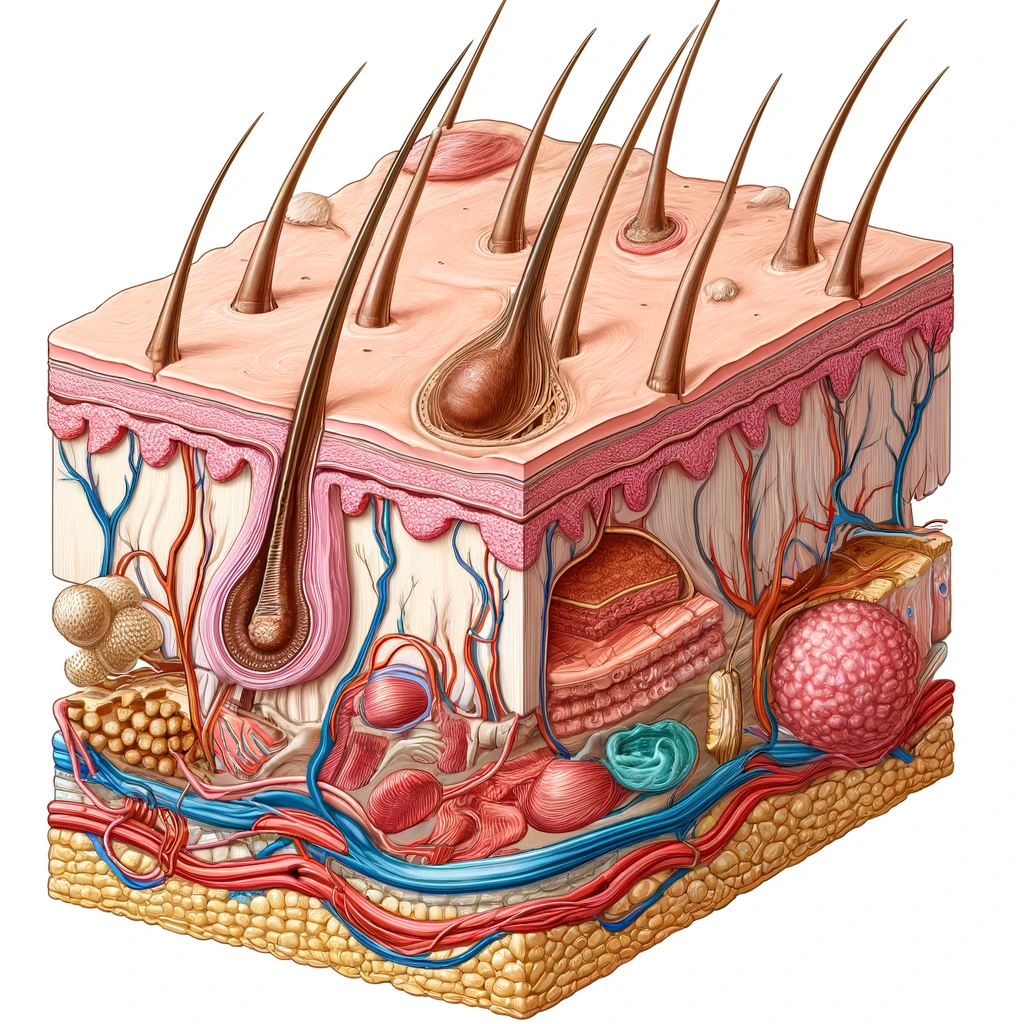The Integumentary System: Your Body’s First Line of Defense
Understanding the Integumentary System
What is the Integumentary System?

Understanding the Integumentary System
What is the Integumentary System?
The integumentary system comprises the skin, hair, nails, and various glands. This system acts as the body’s first line of defense against environmental hazards, helps regulate body temperature, and provides sensory information. It plays a crucial role in protecting internal organs and maintaining overall health.
Major Components of the Integumentary System
Skin
The skin is the largest organ of the body and consists of three primary layers: the epidermis, dermis, and hypodermis. The epidermis is the outermost layer, providing a waterproof barrier and creating our skin tone. The dermis beneath contains tough connective tissue, hair follicles, and sweat glands. The deeper subcutaneous tissue (hypodermis) is made of fat and connective tissue.
Hair and Nails
Hair and nails are made of keratin, a tough protein. Hair helps protect against UV radiation, insulates the body, and enhances sensory perception. Nails protect the sensitive tips of fingers and toes and assist in grasping objects.
Glands
The integumentary system includes various glands, such as sebaceous glands, which produce oil to keep the skin and hair moisturized, and sweat glands, which help regulate body temperature through perspiration. These glands play a significant role in maintaining skin health and homeostasis.
The Importance of Skin Health
H3: Common Disorders
The integumentary system can be affected by various disorders, including acne, eczema, psoriasis, and skin cancer. These conditions can impact both appearance and health, causing discomfort and sometimes leading to more serious health issues.
Maintaining Health
Maintaining healthy skin involves regular cleansing, moisturizing, protecting the skin from excessive sun exposure, and maintaining a balanced diet. Regular check-ups with a dermatologist can help detect and treat skin conditions early, ensuring better skin health and overall well-being.
The integumentary system is vital for protecting the body and maintaining health. Understanding its functions and taking care of your skin, hair, and nails can prevent many common disorders and contribute to a healthier, more vibrant life. Take proactive steps to support your integumentary system and enjoy the benefits of healthy skin.
“Beauty is only skin deep, but a healthy body starts with healthy skin.”
Sign up for our free newsletter to receive a detailed PDF about the integumentary system, including tips for maintaining skin health and preventing common skin disorders. Stay informed and take control of your skin health today!
El Sistema Tegumentario: La Primera Línea de Defensa de Tu Cuerpo

El Sistema Tegumentario: La Primera Línea de Defensa de Tu Cuerpo
Entendiendo el Sistema Tegumentario
¿Qué es el Sistema Tegumentario?
Definición y Función
El sistema tegumentario incluye la piel, el cabello, las uñas y varias glándulas. Este sistema actúa como la primera línea de defensa del cuerpo contra los peligros ambientales, ayuda a regular la temperatura corporal y proporciona información sensorial. Desempeña un papel crucial en la protección de los órganos internos y en el mantenimiento de la salud general.
Componentes Principales del Sistema Tegumentario
Piel
La piel es el órgano más grande del cuerpo y consta de tres capas principales: la epidermis, la dermis y la hipodermis. La epidermis es la capa más externa, proporcionando una barrera impermeable y creando nuestro tono de piel. La dermis debajo contiene tejido conectivo resistente, folículos pilosos y glándulas sudoríparas. El tejido subcutáneo más profundo (hipodermis) está compuesto de grasa y tejido conectivo.
Cabello y Uñas
El cabello y las uñas están hechos de queratina, una proteína resistente. El cabello ayuda a proteger contra la radiación UV, a aislar el cuerpo y a mejorar la percepción sensorial. Las uñas protegen las puntas sensibles de los dedos de las manos y los pies y ayudan a agarrar objetos.
Glándulas
El sistema tegumentario incluye varias glándulas, como las glándulas sebáceas, que producen aceite para mantener la piel y el cabello hidratados, y las glándulas sudoríparas, que ayudan a regular la temperatura corporal a través de la transpiración. Estas glándulas desempeñan un papel significativo en el mantenimiento de la salud de la piel y la homeostasis.
La Importancia de la Salud de la Piel
Trastornos Comunes
El sistema tegumentario puede verse afectado por varios trastornos, como el acné, el eczema, la psoriasis y el cáncer de piel. Estas condiciones pueden afectar tanto la apariencia como la salud, causando incomodidad y, a veces, llevando a problemas de salud más graves.
Manteniendo la Salud
Mantener la piel saludable implica una limpieza regular, hidratación, protección contra la exposición solar excesiva y mantener una dieta equilibrada. Las visitas regulares a un dermatólogo pueden ayudar a detectar y tratar las condiciones de la piel temprano, asegurando una mejor salud de la piel y un bienestar general.
El sistema tegumentario es vital para proteger el cuerpo y mantener la salud. Entender sus funciones y cuidar tu piel, cabello y uñas puede prevenir muchos trastornos comunes y contribuir a una vida más saludable y vibrante. Toma medidas proactivas para apoyar tu sistema tegumentario y disfruta de los beneficios de una piel saludable.
“La belleza es sólo superficial, pero un cuerpo sano comienza con una piel sana.”
Suscríbete a nuestro boletín gratuito para recibir un PDF detallado sobre el sistema tegumentario, incluyendo consejos para mantener la salud de la piel y prevenir trastornos comunes de la piel. ¡Mantente informado y toma el control de la salud de tu piel hoy!